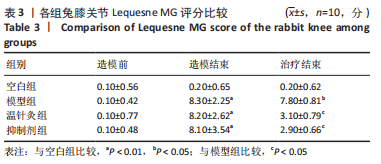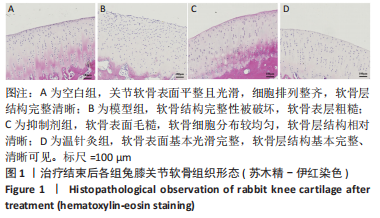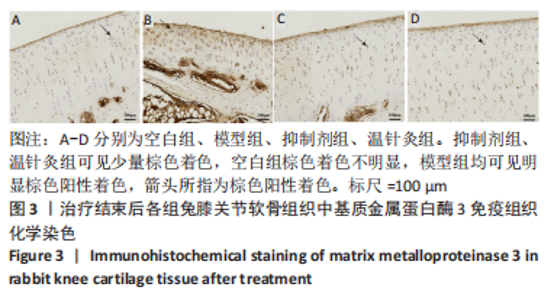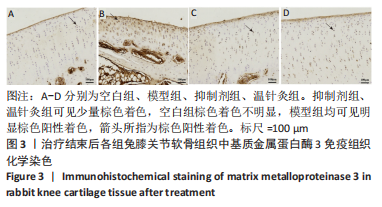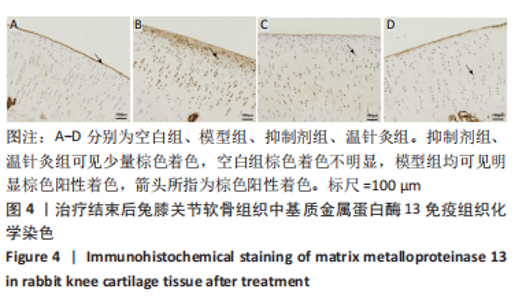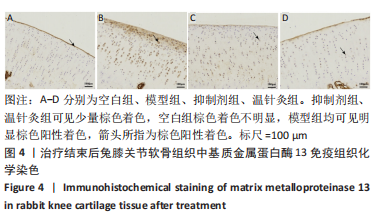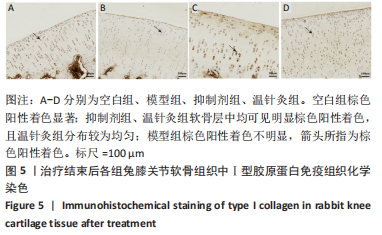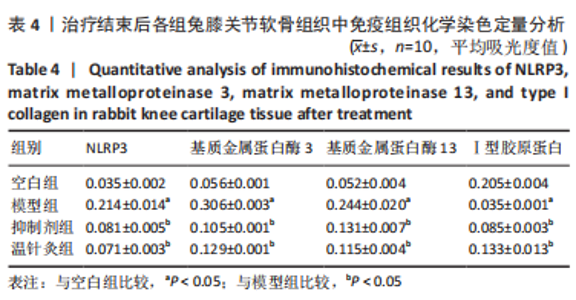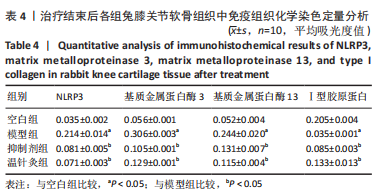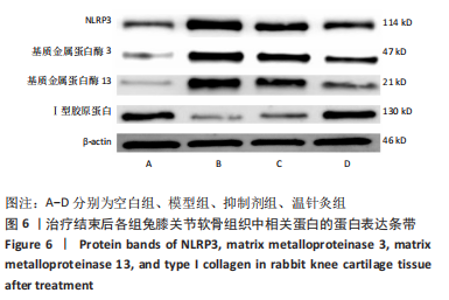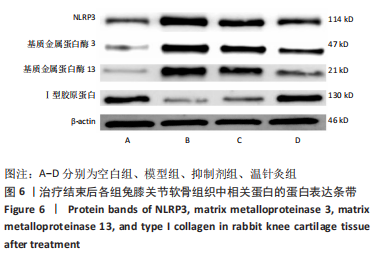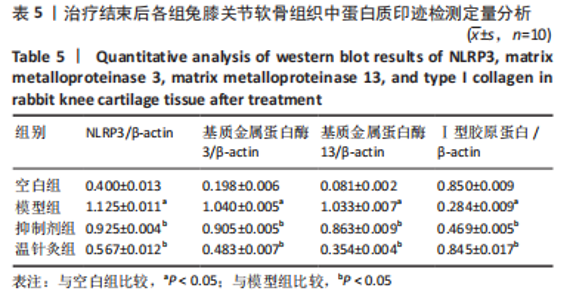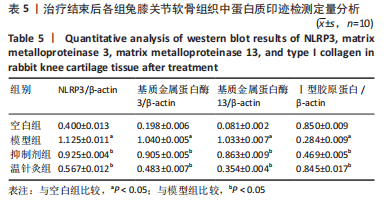Chinese Journal of Tissue Engineering Research ›› 2023, Vol. 27 ›› Issue (20): 3202-3208.doi: 10.12307/2023.429
Previous Articles Next Articles
Warm-needling moxibusion inhibits NLRP3 inflammasome activation and improves cartilage injury in a rabbit model of knee osteoarthritis
Wu Yongli1, 2, Li Long3, Liu Junwei1, Liu Di1, Wang Duo3
- 1Department of Orthopedics and Traumatology of Traditional Chinese Medicine, General Hospital of Ningxia Medical University, Yinchuan 750004, Ningxia Hui Autonomous Region, China; 2Key Laboratory of Ningxia Ethnomedicine Modernization, Ministry of Education, Ningxia Medical University, Yinchuan 750004, Ningxia Hui Autonomous Region, China; 3School of Traditional Chinese Medicine, Ningxia Medical University, Yinchuan 750004, Ningxia Hui Autonomous Region, China
-
Received:2022-04-16Accepted:2022-06-23Online:2023-07-18Published:2022-11-19 -
Contact:Wu Yongli, Department of Orthopedics and Traumatology of Traditional Chinese Medicine, General Hospital of Ningxia Medical University, Yinchuan 750004, Ningxia Hui Autonomous Region, China; Key Laboratory of Ningxia Ethnomedicine Modernization, Ministry of Education, Ningxia Medical University, Yinchuan 750004, Ningxia Hui Autonomous Region, China -
About author:Wu Yongli, Professor, Chief physician, Doctoral supervisor, Department of Orthopedics and Traumatology of Traditional Chinese Medicine, General Hospital of Ningxia Medical University, Yinchuan 750004, Ningxia Hui Autonomous Region, China; Key Laboratory of Ningxia Ethnomedicine Modernization, Ministry of Education, Ningxia Medical University, Yinchuan 750004, Ningxia Hui Autonomous Region, China -
Supported by:the National Natural Science Foundation of China, Nos. 82160939 and 81760891 (both to WYL); The Second Batch of Science and Technology Leading Talents Project of Ningxia Hui Autonomous Region, No. KJT201610 (to WYL)
CLC Number:
Cite this article
Wu Yongli, Li Long, Liu Junwei, Liu Di, Wang Duo. Warm-needling moxibusion inhibits NLRP3 inflammasome activation and improves cartilage injury in a rabbit model of knee osteoarthritis[J]. Chinese Journal of Tissue Engineering Research, 2023, 27(20): 3202-3208.
share this article
Add to citation manager EndNote|Reference Manager|ProCite|BibTeX|RefWorks
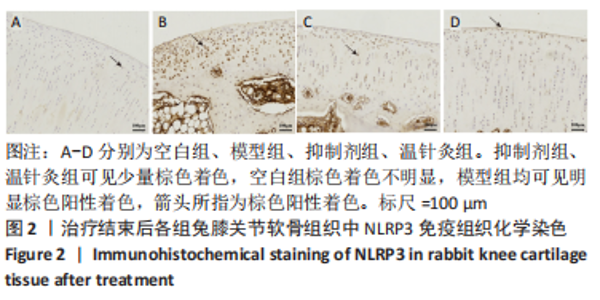
空白组、模型组、温针灸组、抑制剂组改良Mankin’s评分分别为0.30±0.64,8.60±0.73,4.20±0.83,4.30±0.65。与空白组比较,模型组改良Mankin’s评分显著升高(P < 0.01);与模型组比较,温针灸组、抑制剂组改良Mankin’s评分显著降低(P均< 0.05)。 2.4 各组兔膝关节软骨组织免疫组织化学染色结果 NLRP3、基质金属蛋白酶3、基质金属蛋白酶13蛋白多分布于软骨层且在各组中均有表达,抑制剂组、温针灸组都可见少量棕色着色,空白组蛋白阳性表达均不明显,模型组均可见明显棕色阳性着色,提示阳性蛋白较多,见图2-4。抑制剂组、温针灸组软骨层中均可见明显Ⅰ型胶原蛋白棕色阳性着色,且温针灸组分布较为均匀,提示Ⅰ型胶原蛋白较多;空白组Ⅰ型胶原蛋白阳性着色显著,模型组Ⅰ型胶原蛋白阳性表达不明显,见图5。"
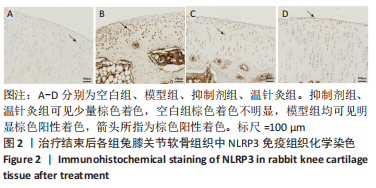
| [1] FANG T, ZHOU X, JIN M, et al. Molecular mechanisms of mechanical load-induced osteoarthritis. Int Orthop. 2021;45(5):1125-1136. [2] ZHANG F, ZHAO W, ZHOU J, et al. Heat shock transcription factor 2 reduces the secretion of IL-1β by inhibiting NLRP3 inflammasome activation in ulcerative colitis. Gene. 2021;768:145299. [3] 吴俊东,耿智隆,杨勇丽,等.NLRP3炎症小体激活机制及其在脓毒症中的作用[J].医学综述,2021,27(3):459-464+470. [4] DAI Y, ZHANG J, XIANG J, et al. Calcitriol inhibits ROS-NLRP3-IL-1β signaling axis via activation of Nrf2-antioxidant signaling in hyperosmotic stress stimulated human corneal epithelial cells. Redox Biol. 2019;21:101093. [5] 欧阳谭亮,武志娟,钟金城.MMP-2和MMP-9在骨骼肌组织中的研究进展[J].生命科学,2021,33(10):1286-1295. [6] 刘楠楠.DDR2的相互作用分子-Vimentin在RA滑膜基质金属蛋白酶过分泌及 FLS细胞侵袭、迁移中的作用研究[D].西安:第四军医大学, 2015. [7] 郭洁梅.从LXRs/NF-κB通路探讨壮骨健膝方对KOA滑膜炎症影响的实验研究[D].福州:福建中医药大学,2021. [8] YUE P, GAO L, CHEN M, et al. Effect of Warm-needle-moxibustion on Behavior Reactions and TNF-α and MMP-3 Contents in Knee Cartilage of Rabbits with Knee Osteoarthritis. Zhen Ci Yan Jiu. 2016;41(3):235-239. [9] 张艳玲,杨磊,刘君伟,等.温针灸与骨髓间充质干细胞移植对兔膝骨性关节炎模型血清中MMP-1、MMP-13和IL-10表达的影响[J].宁夏医学杂志,2020,42(12):1057-1060+1056. [10] MCALLISTER MJ, CHEMALY M, EAKIN AJ, et al. NLRP3 as a potentially novel biomarker for the management of osteoarthritis. Osteoarthritis Cartilage. 2018;26(5):612-619. [11] BAI H, YUAN R, ZHANG Z, et al. Intra-articular Injection of Baicalein Inhibits Cartilage Catabolism and NLRP3 Inflammasome Signaling in a Posttraumatic OA Model. Oxid Med Cell Longev. 2021;2021:6116890. [12] LIU J, HUANG X, ZHOU J, et al. Pulsed electromagnetic field alleviates synovitis and inhibits the NLRP3/Caspase-1/GSDMD signaling pathway in osteoarthritis rats. Electromagn Biol Med. 2022;41(1):101-107. [13] WANG Z, CHEN M, WANG B, et al. Electroacupuncture Alleviates Osteoarthritis by Suppressing NLRP3 Inflammasome Activation in Guinea Pigs. Evid Based Complement Alternat Med. 2020;2020:5476064. [14] HE Z, NIE P, LU J, et al. Less mechanical loading attenuates osteoarthritis by reducing cartilage degeneration, subchondral bone remodelling, secondary inflammation, and activation of NLRP3 inflammasome. Bone Joint Res. 2020;9(10): 731-741. [15] YANG Y, WANG Y, KONG Y, et al. Moderate mechanical stimulation protects rats against osteoarthritis through the regulation of TRAIL via the NF-kappaB/ NLRP3 pathway. Oxid Med Cell Longev. 2020;2020: 6196398. [16] 武晏屹,白明,田硕,等.基于中西医临床病症特点的膝骨关节炎动物模型分析[J].中国中药杂志,2020,45(11):2481-2485. [17] 陈人智,王明磊,朱凯,等.管型石膏伸直位固定法对兔KOA模型膝关节X线及MRI检查改变的研究[J].宁夏医科大学学报,2019,41(5):446-449. [18] ZHANG W, GAO Y, GUO C, et al. Effect of acupotomy versus electroacupuncture on ethology and morphology in a rabbit model of knee osteoarthritis. J Tradit Chin Med. 2019;39(2):229-236. [19] 马笃军,华树良,彭力平,等.牛膝醇提物对实验兔膝骨关节炎模型AMPK/Wnt/MAPK信号通路串话的影响[J].中医药导报,2021,27(7):16-21+26. [20] 许学猛,刘文刚,詹红生,等.肌肉训练康复治疗膝痹(膝骨关节炎)专家共识[J].按摩与康复医学 ,2020,11(19):1-4. [21] 马永圆,郭海云,白福海,等.电针治疗膝骨关节炎的基础研究进展[J].上海针灸杂志,2018,37(7):833-840. [22] 詹红生,潘富伟.膝骨关节炎治疗中不可或缺的基础治疗——《膝骨关节炎中医诊疗指南(2020年版)》解读[J].中医正骨,2021,33(8):1-6. [23] 任毅,刘菲,张愉,等.“短刺法”对兔膝骨关节炎软骨中Col-Ⅰ及其标记物表达的影响及影像学观察[J].中国针灸,2016,36(6):622-628. [24] 王晓玲,王芗斌,侯美金,等.温针灸治疗膝骨关节炎:随机对照研究[J].中国针灸,2017,37(5):457-462. [25] PALADA V, SIDDIQAH AHMED A, HUGO A, et al. Expression of mitochondrial TSPO and FAM173B is associated with inflammation and symptoms in patients with painful knee osteoarthritis. Rheumatology (Oxford). 2021; 60(4):1724-1733. [26] 李晓辰,邢润麟,张农山,等.“易层”贴敷抑制NLRP3炎症小体激活改善膝骨关节炎的实验研究[J].时珍国医国药,2020,31(3):741-745. [27] COLL RC, ROBERTSON AA, CHAE JJ, et al. A small-molecule inhibitor of the NLRP3 inflammasome for the treatment of inflammatory diseases. Nat Med. 2015;21(3):248-255. [28] GE Q, CHEN X, ZHAO Y, et al. Modulatory mechanisms of NLRP3: Potential roles in inflammasome activation. Life Sci. 2021;267:118918. [29] DAI Y, ZHANG J, XIANG J, et al. Calcitriol inhibits ROS-NLRP3-IL-1β signaling axis via activation of Nrf2-antioxidant signaling in hyperosmotic stress stimulated human corneal epithelial cells. Redox Biol. 2019;21:101093. [30] HOSHI H, AKAGI R, YAMAGUCHI S, et al. Effect of inhibiting MMP13 and ADAMTS5 by intra-articular injection of small interfering RNA in a surgically induced osteoarthritis model of mice. Cell Tissue Res. 2017;368(2):379-387. [31] 廖太阳,王培民,张农山,等.NLRP3炎症小体在KOA发病机制中的作用研究[J].中国比较医学杂志,2021,31(12):91-96. [32] 陈达.补肾壮筋汤抑制炎症介导骨关节炎软骨基质降解的作用机制研究[D].福州:福建中医药大学,2018. [33] CUI N, HU M, KHALIL RA. Biochemical and Biological Attributes of Matrix Metalloproteinases. Prog Mol Biol Transl Sci. 2017;147:1-73. [34] CUENO ME, OCHIAI K. Gingival Periodontal Disease (PD) Level-Butyric Acid Affects the Systemic Blood and Brain Organ: Insights Into the Systemic Inflammation of Periodontal Disease. Front Immunol. 2018;9:1158. [35] ZHANG L, QIU J, SHI J, et al. MicroRNA-140-5p represses chondrocyte pyroptosis and relieves cartilage injury in osteoarthritis by inhibiting cathepsin B/Nod-like receptor protein 3. Bioengineered. 2021;12(2): 9949-9964. [36] LI W, WANG Y, TANG Y, et al. Quercetin Alleviates Osteoarthritis Progression in Rats by Suppressing Inflammation and Apoptosis via Inhibition of IRAK1/NLRP3 Signaling. J Inflamm Res. 2021;14:3393-3403. [37] ZU Y, MU Y, LI Q, et al. Icariin alleviates osteoarthritis by inhibiting NLRP3-mediated pyroptosis. J Orthop Surg Res. 2019;14(1):307. [38] XU G, WANG J, MA L, et al. Local intra-articular injection of rapamycin inhibits NLRP3 activity and prevents osteoarthritis in mouse DMM models. Autoimmunity. 2019;52(4):168-175. [39] TAN Q, LI J, LI BC, et al. Warm needling reduces oxidative damage and inflammation of cartilage in knee osteoarthritis rats. Zhen Ci Yan Jiu. 2022; 47(4): 321-328. [40] COLL RC, HILL JR, DAY CJ, et al. MCC950 directly targets the NLRP3 ATP-hydrolysis motif for inflammasome inhibition. Nat Chem Biol. 2019;15(6): 556-559. [41] PASCART T, RICHETTE P. Investigational drugs for hyperuricemia, an update on recent developments. Expert Opin Investig Drugs. 2018;27(5):437-444. |
| [1] | Li Xiaomin, Tian Xiangdong, Tan Yetong, Zhu Guangyu, Wang Rongtian, Wang Jian, Xue Zhipeng, Ma Sheng, Hu Yuanyi, Huang Ye, Ding Tiansong. Changes of lower limb force line and knee function after high tibial osteotomy in osteoporotic medial ventricular knee osteoarthritis [J]. Chinese Journal of Tissue Engineering Research, 2023, 27(9): 1325-1329. |
| [2] | Long Guiyue, Li Dongdong, Liao Hongbing. Calcium phosphate cement/poly(lactic-co-glycolic acid) degradation products promote osteoclast differentiation of mouse monocytes [J]. Chinese Journal of Tissue Engineering Research, 2023, 27(8): 1193-1198. |
| [3] | Guo Yingqi, Gong Xianxu, Zhang Yan, Xiao Han, Wang Ye, Gu Wenguang. Meniscus extrusion and patellofemoral joint cartilage injury and bone marrow lesions: MRI semi-quantitative score [J]. Chinese Journal of Tissue Engineering Research, 2023, 27(4): 600-605. |
| [4] | Wan Guoli, Shi Chenhui, Wang Weishan, Li Ang, Shi Xunda, Cai Yi. Retrospective analysis of the influencing factors of chronic pain after total knee arthroplasty [J]. Chinese Journal of Tissue Engineering Research, 2023, 27(4): 558-564. |
| [5] | Li Xiaomin, Tian Xiangdong, Tan Yetong, Xue Zhipeng, Ma Sheng, Hu Yuanyi, Huang Ye, Ding Tiansong. Effect of distal tibial tuberosity-high tibial osteotomy on patellofemoral joint degeneration and patellar height [J]. Chinese Journal of Tissue Engineering Research, 2023, 27(27): 4367-4372. |
| [6] | Hu Wei, Yan Xianke . Effect of posterior cruciate ligament preserving knee prosthesis on gait and lower extremity venous return in varus knee arthroplasty [J]. Chinese Journal of Tissue Engineering Research, 2023, 27(22): 3503-3507. |
| [7] | Chen Hao, Wang Rui, Jiang Shaowei, Wu Lei. Correlation of MRI quantitative measurement of medial meniscus extrusion and medial meniscus injury pattern with cartilage damage [J]. Chinese Journal of Tissue Engineering Research, 2023, 27(22): 3567-3572. |
| [8] | Zhao Zhongsheng, Zheng Ruoxi, Lin Jie, Chen Jun, Ye Jinxia, Fu Changlong, Wu Guangwen. Rongjin Niantong Fang for treating knee osteoarthritis by regulating cartilage matrix metabolism [J]. Chinese Journal of Tissue Engineering Research, 2023, 27(20): 3195-3201. |
| [9] | Xie Pingjin, Luo Zhen, Lu Qigui, Guo Yanxing, Chen Qunqun, Li Feilong. Effect of ligustrazine and overexpression of miR-20b-5p on synovial, cartilage and subchondral bone angiogenesis in rats with early-stage knee osteoarthritis: a histological observation [J]. Chinese Journal of Tissue Engineering Research, 2023, 27(2): 237-245. |
| [10] | Li Shichao, Xie Guangyue, Sun Zhen, Han Peng, Hou Xiaohua, Sun Xiaowei, Zhang Qidong. Correlation of knee joint alignment correction between valgus stress and postoperative radiography after unicompartmental knee arthroplasty [J]. Chinese Journal of Tissue Engineering Research, 2023, 27(18): 2910-2914. |
| [11] | Li Fang, Cao Jianmin, Zhai Pengfei, Wang Jianshe, Hong Da. Effects of resveratrol on albumin-induced pyroptosis-related proteins in HK-2 cells [J]. Chinese Journal of Tissue Engineering Research, 2023, 27(14): 2164-2169. |
| [12] | Wu Di, Si Lina, Wu Lizhu, Wang Jianhua, Luo Jinwei, Chang Qiankun, Lyu Yongming, Du Yuanliang. Feasibility of three-dimensional printing technology combined with computer-aided design in total knee arthroplasty for severe knee osteoarthritis [J]. Chinese Journal of Tissue Engineering Research, 2023, 27(13): 2051-2057. |
| [13] | Guo Zonglei , Wang Yehua, Liu Guangluan. Knee rotation and patellar instability [J]. Chinese Journal of Tissue Engineering Research, 2023, 27(13): 2099-2103. |
| [14] | Wang Xuejiao, Shi Wenjuan, Zhang Yan, Xing Dehai, Li Dongxue, Jiao Xiangying. Role of thioredoxin-interacting protein-mediated inflammatory response and apoptosis in myocardial infarction [J]. Chinese Journal of Tissue Engineering Research, 2023, 27(11): 1715-1721. |
| [15] | Zhang Yujuan, Yuan Yitong, Du Ruochen, Tian Feng, Fu Yuan, Wang Chunfang. miR-31 promotes the proliferation and migration of bone marrow mesenchymal stem cells [J]. Chinese Journal of Tissue Engineering Research, 2023, 27(1): 66-71. |
| Viewed | ||||||
|
Full text |
|
|||||
|
Abstract |
|
|||||

